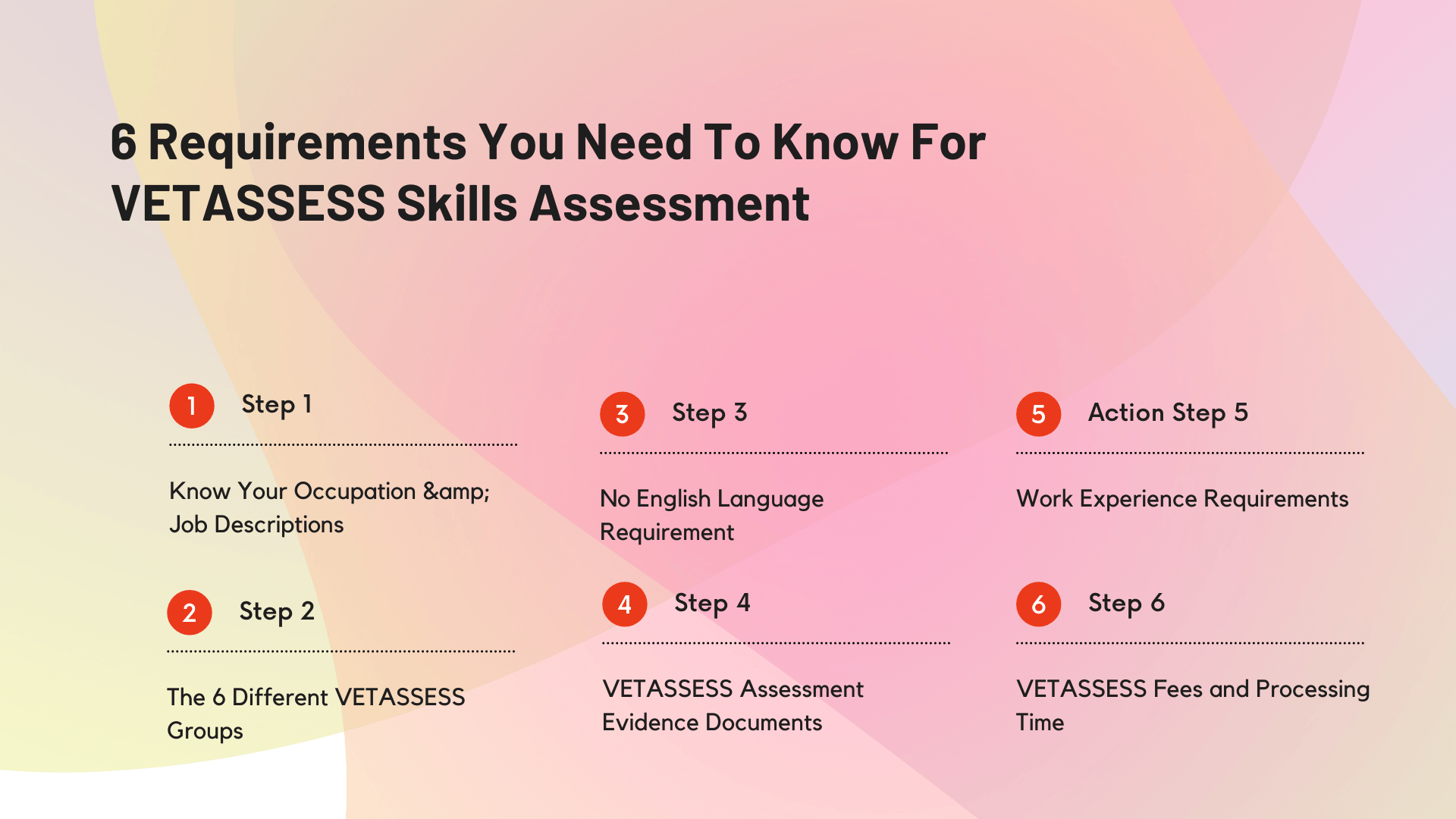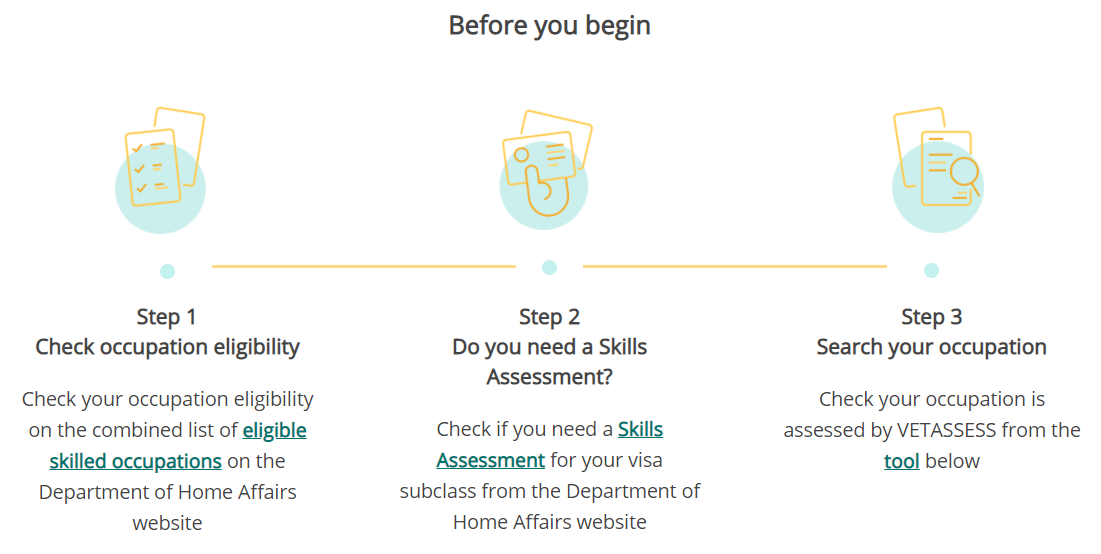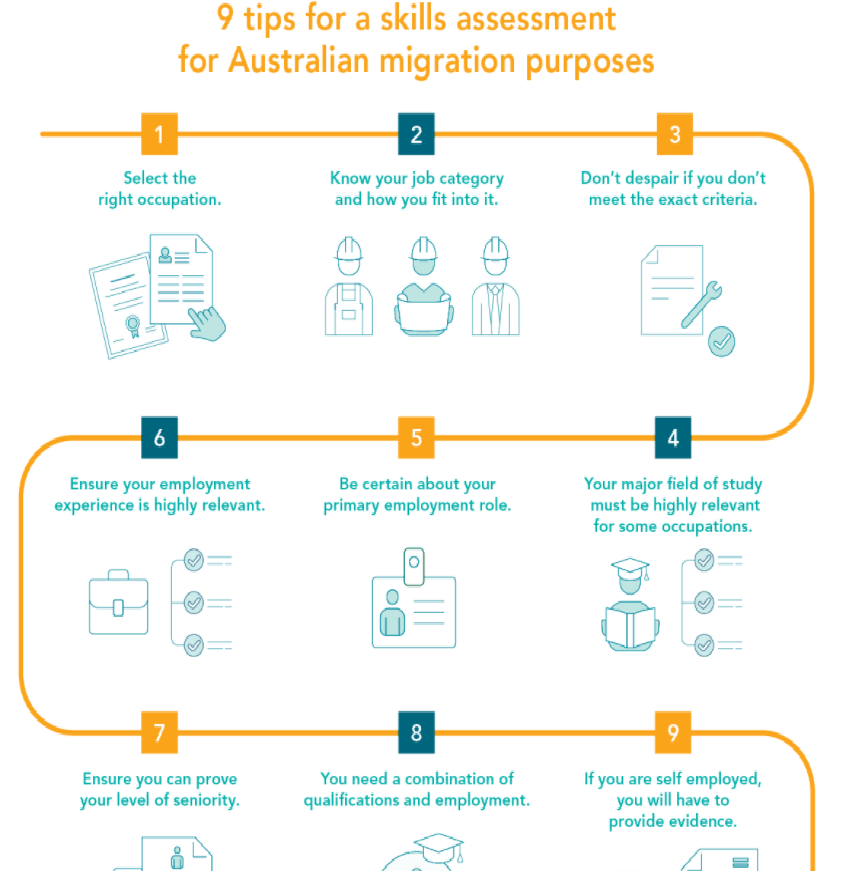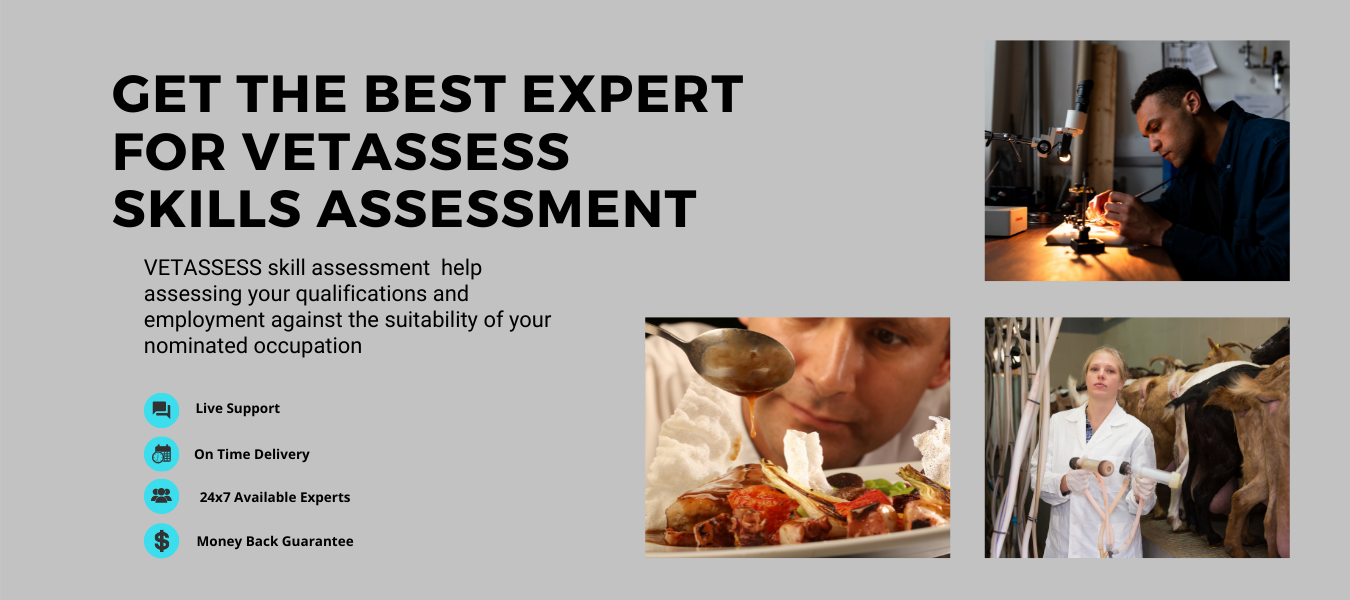VETASSESS is the largest Australian skills assessment authority, which is authorized by the Australian Government.
This assessment authority is globally recognized for its expertise in assessments, which comes from 25 years of experience in evaluating the qualification and work experience of prospective migrants, and
supporting individuals’ applications for employment, course entry and industry leadership. It evaluates 28 trade occupations and more than 360 professional
occupations from different types of industries.
VETASSESS SKILL ASSESSMENT
VETASSESS full skills assessment involves assessing your qualifications and employment against the suitability of your nominated occupation. A positive assessment of both qualifications and employment is required for a successful skills assessment for migration purposes.
A skill assessment is a major step in the immigration process for an individual who is planning to migrate to Australia on a skilled visa. One of the major skill evaluation authorities in Australia is VETASSESS, whose full form is Vocational Education and Training Assessment Services). VETASSESS takes up the responsibility for assessing the skills and qualifications of an individual desiring to migrate to Australia under the General Skilled Migration (GSM) program or for employer-sponsored migration. The evaluation process is to determine if an individual’s qualifications and experience are equal to the Australian standard for the chosen occupation.
The VETASSESS skill assessment process consists of a painstaking assessment of an individual’s qualifications and working experience and may include a practical evaluation or/and interview. An applicant needs to provide proof of their qualifications like academic transcripts and certificates and work experience such as payslips and employment references.
VETASSESS will then evaluate if an individual’s qualifications and experience are related to their chosen occupation and whether they satisfy the required level of competence and skill for that occupation. If having completed the assessment process, VETASSESS will issue a skills assessment outcome letter, used as proof of an individual’s qualifications and skills when they apply for a skilled visa to Australia.
Skills Assessment for Migration
Necessary documents
All documents must be exceptional colour copies of the original documents. In the case of having your documents not available in English, submit copies of the original documents as well as the English translations that are made by a registered translation service.
Important information: Qualification and employment requirements are subject to change across occupations and DAMAs. So, check the requirements for your occupation with your particular DAMA.
Occupation assessments without DAMA-specific criteria will adhere to the same assessment process as for full skills assessment applications for migration.
- Application Fee
- Proof of identity
- Change of name
- Qualification evidence
- Employment evidence
- Resume /curriculum vitae
- Photograph
Fee Schedule for DAMA Skills Assessments
| Service |
Fee (candidate within Australia) |
Fee (candidate outside Australia) |
| Skills Assessment |
$968.00 |
$880.00 |
| Outcome Review – Employment |
$537.90 |
$489.00 |
| Outcome Review – Qualification |
$299.20 |
$272.00 |
6 Requirements You Need To Know For VETASSESS Skills Assessment
The Department of Home Affairs requires Australian Skilled Visa applicants to provide detailed information regarding their qualifications and employment history. To ensure you meet the Australian qualifications, Home Affairs requires that you complete a migration skills assessment form an assessing authority.
The General Skilled Migration (GSM) visa is the most common visa programme for overseas professionals, managers, tradespersons, and international graduates in Australia to apply for residency. When migrating to Australia for a skilled occupation it is necessary to have a positive skill assessment. The skills assessment application must be processed by a relevant professional agency in Australia before lodging a visa application.
The first step in completing your skills assessment and lodging your application is to review the skilled occupation list and understand your occupations requirements. Once you have identified your occupation it is time to begin the skills assessment process.
There are more than 20 skills assessment agencies, including, Australian Computer Society (ACS), Engineer Australia (EA), CPA Australia, and VETASSESS.
VETASSESS is Australia’s leading vocational education and training assessment provider, it provides skills assessments for General Professional Occupations as well as Trade Occupations. VETASSESS reviews many popular occupations under General Occupations, e.g. Marketing Specialist, Property Manager, Conference and Event Organiser and Customer Service Manager.

1) Know Your Occupation & Job Descriptions
To start your skilled application process you must review the skilled occupation lists for your specific visa; 189 occupation list and 190 / 489 skilled occupation list. Below you will find two examples of nominated occupations and their job requirements.
Marketing Specialist - ANZSCO 225113
- Researching potential demand and market characteristics for new goods and services and collecting and analyzing data and other statistical information
- Supporting business growth and development through the preparation and execution of marketing objectives, policies, and programs
- Commissioning and undertaking market research to identify market opportunities for new and existing goods and services
- Advising on all elements of marketing such as product mix, pricing, advertising, and sales promotion, selling, and distribution channels
Customer Service Manager - ANZSCO 149212
- Providing direction and feedback to team members and assisting with recruitment
- Managing, motivating and developing staff providing customer services
- Planning and implementing after-sales services to follow up customer satisfaction, ensure the performance of goods purchased and modify and improve services provided
- Liaising with other organizational units, service agents and customers to identify and respond to customer expectations
2) No English Language Requirement
One benefit of taking the VETASSESS skills assessment is that it does not require English language skills assessments such as IELTS test results. With that being said, most VETASSESS skill level qualifications do require post-secondary education.
3) Work Experience Requirements
VETASSESS requires a minimum of 1 year post-qualification highly related work experience for General Occupations.
4) The 6 Different VETASSESS Groups
VETASSESS has 6 different groups for General Occupations. VETASSESS has categorized its general occupations into groups A, B, C, D, E, and F for assessment purposes according to the indicative skill level on ANZSCO. The table below outlines the corresponding groups with their skill level but does not include group F due to it only having one occupation.
5) VETASSESS Assessment Evidence Documents
1.Identity documents:
- Copy of current passport
- One recent passport size photo (45mm X 35mm)
2. Qualification evidence
- Qualification award certificate
- Academic transcript
3. Employment evidence and updated CV
- Statement of Service from employers
- Payment evidence
- Employment contracts
6) VETASSESS Fees and Processing Time
- AUD 968.00 for standard assessment, 10 to 12 weeks
- AUD 1628.00 for priority processing, 10 business days
List of Required Documents
All documents must be high quality colour copies of the original documents. If your documents are not in English, you must submit copies of the original documents as well as the English translations made by a registered translation service.Expand All.
- 1. Application Fee
- 2. Photograph
- 3. Proof of identity
- 4. Change of name
- 5. Qualification evidence
- 6. Employment evidence

9 tips for a skills assessment for Australian migration purposes
Here are our top nine tips for applicants:
1. Selecting the right occupation for a skills assessment can be the most difficult step in the process. Your skills will be assessed against Australian standards for the occupation you nominate, which measure these key points:
- Your qualifications (level).
- Your work experience, including.
- The time you have spent working in your role (career progression).
- How your qualifications and employment experience interact, or collectively, meet criteria for the occupation.
2. Know your job category and how you fit into it.This isn’t as obvious as it might seem. Be aware that your qualifications and how you perform the job may differ from how Australian industries operate even though it’s the standard in your home country. We assess employment roles against the Australian and New Zealand Standard Classification of Occupations (ANZSCO), which lists the benchmark qualifications, employment and the expected skill level required for each occupation.
Don’t underestimate the requirements of your occupation category – for example for some occupations, it’s not enough to only have practical experience or to have worked in a senior role in an occupation if you don’t hold the required qualification level specified in our criteria.
3. Don’t despair if you don’t meet the exact criteria for an occupation. You may have other options. For example, we assess over 350 occupations. Although you may hold the position of a scientist in your current job, you might not meet the qualification level criteria Australia requires. However, you may be able to apply as a skilled migrant in another category, such as at the technician level.
4. In many categories of occupation, your major field of study must not only relate to your occupation but be assessed “highly relevant”.
As an example, the role of dental hygienist requires highly relevant qualifications in the area of dental hygiene, dental hygiene therapy or oral health therapy. Studies and employment in dentistry or dental surgery cannot be assessed positively for this occupation because they are not considered highly relevant to current Australian industry standard practice.
5. Be certain about your primary employment role. This must relate primarily to your nominated occupation for skills assessment purposes. You might perform several roles in your organization, but you need to have worked in the role of your nominated occupation and performed tasks at the required skill level of that occupation as it is outlined in ANZSCO.
6. Ensure your employment experience is highly relevant to your nominated occupation. Applicants can make the mistake of assuming that because they have worked in a particular job in their industry, they could easily perform another role in that industry.
You possibly could do the job, but for skills assessment purposes, you need to demonstrate that you have actually performed the job and at the skill level required.
7. Ensure you can prove your level of seniority. We will look for evidence of your position within the organizations where you have worked. Can you demonstrate your scope of responsibility and level of authority in the work you have performed? Where do you sit within the organizational structure? Is this shown on an organizational chart you can provide? For assessment of our managerial occupations and some additional ones we require an organizational chart. The types of proof we require may also include evidence of projects you have been involved in.
8. Understand the combination of qualification and employment that you will need
before you apply. This is where applicants can easily go wrong by applying when they only meet some of the criteria.
For example, in some of the occupations we assess that require a Bachelor degree, you can apply with a:
- Qualification(s) assessed at AQF Bachelor degree (or higher degree) with a highly relevant field of study and at least one year of post-qualification highly relevant employment performed at the appropriate skill level in the last five years.
or
- Qualification(s) assessed at AQF Bachelor degree (or higher degree) with an additional qualification assessed at the level of an Australian Qualifications Framework (AQF) Diploma level in a highly relevant field of study and at least two years of post-qualification highly relevant employment performed at the appropriate skill level in the last five years.
or
- Qualification(s) assessed at AQF Bachelor degree (or higher degree) without a highly relevant field of study and at least three years of post-qualification highly relevant employment performed at the appropriate skill level in the last five years.
Be aware that the above level of assessments considers your work experience after you gained your Bachelor degree level qualification, but you can also apply with pre-qualification employment and there are different rules around this.
9. If you are self-employed, you will have to provide evidence of this such as documentation from your accountant and business registration details. Other evidence may includes bank statements showing you have received regular income from your self-employment, taxation evidence, contracts, client testimonials and evidence of projects.
As you can see, it’s important to understand how the assessment system operates, how your qualifications and work experience will be assessed in combination, and the importance of the words “highly relevant”.
If this seems too complicated, be assured that Australia welcomes skilled migrants. In the 2018-19 financial year, over 109,000 people emigrated to Australia under the Skilled Migration Program, bringing their valuable skills to help build the economy. When you arrive in Australia, most of the people you meet will be migrants or the children of migrants, people who once arrived, as you are now, to start a new life for themselves and their families.

You can find VETASSESS list of general professional occupations Here.
https://www.vetassess.com.au/portals/0/downloads/qualification_assessment/vetassess-general-occupation-list.pdf?vid=100
FAQs
Does Vetassess require work experience?
Work experience is not required for a Qualifications-only assessment to support a Temporary Graduate (subclass 485) visa. VETASSESS will only need to assess evidence of your relevant employment to complete the assessment.
How long does a Vetassess skills assessment take?
The approximate time for a full Skills Assessment is 9-10 weeks, once we have received all documents and information required for the assessment.
How do I apply for Vetassess?
Apply or Track Your Application-
- 1. Review the application process.
- 2. Check the application fees.
- 3. Read the Fact Sheet for your occupation to see the skills and knowledge you need to demonstrate in your assessment.
- 4. Gather your training and employment evidence. Download Evidence Guide (548KB pdf)
Does Vetassess require work experience?
VETASSESS requires a minimum of 1 year post-qualification highly related work experience for General Occupations.
Top 5 mistakes applicants make when applying for the VETASSESS Skills Assessment
You are a Professional, have made the big decision to migrate to Australia and have found out you need a VETASSESS skills assessment before you can proceed with a visa application. You are now asking yourself what is a skills assessment and what is VETASSESS?
The VETASSESS website tells you that their service assesses your qualifications to see if they are comparable to the equivalent qualification in Australia. Here, VETASSESS is mainly discussing a bachelor degree qualification and any subsequent post-graduate qualifications. Further, VETASSESS will assess your post-Bachelor degree work experience for relevancy to your nominated occupation and provide a determination of your qualified work experience. The Department of Home Affairs will use this skills assessment to assess the points given for qualifications and relevant work experience.
You then decide that the rest of the VETASSESS website is pretty overwhelming! We agree. With that in mind, we have compiled a list of the top 5 mistakes applicants make and how you can avoid them so that your skills assessment comes back positive and maximizes the qualification and work experience points you are eligible for.
1. Being too modest in your CV/Resume!
VETASSESS can only assess your qualifications and work experience if there is enough detail there to assess! This is your time to shine and really promote yourself! Your CV/Resume and Work reference statements need to have a lot of description about your duties and these descriptions need to be very closely matched to the ANZSCO duties for the occupation…but not exactly the wording in ANZSCO. It is a very fine balancing act and if you are not sure what ANZSCO is or how VETASSESS and the Department of Home Affairs use it, are you sure you are presenting your CV/Resume in the best way for the skills assessment and visa application?
2. Getting your employer to prepare the work statement
Like the CV/Resume, getting the right amount of detail right is key. VETASSESS and the Department of Home Affairs are looking for some core features to appear in these letters. A simple Employment Reference that states you worked for XX company for 5 years in XX role that the HR Manager prepared on his/her lunch break will not get you a positive skills assessment.
You will need to prepare a draft letter for the employer to sign on company letterhead again making sure that there is sufficient detail and overlap with the ANZSCO occupation information to really highlight your relevant work experience to maximize points here.
Unfortunately, a ‘cut and paste’ from the ANZSCO occupation listed duties will also get you a refusal. The employment statement must be tailored to your role! What a lot of detail to juggle!
3. Inconsistent details
VETASSESS are very focused on the detail. Are you? If dates, names and places, etc., are not consistent across your document evidence, this could be an issue for your skills assessment. If you are a ‘big picture’ kind of person or do not have enough time to invest to really get into the detail, this could be an issue for your skill assessment in Australia and subsequent visa application.
4. Not submitting all of your work experience or the wrong experience
The aim here is to maximize your claimable points for relevant work experience. Do you have hidden work experience that might work in your favour here? Paid work that is greater than 20 hours per week can be used! For certain occupations, paid PhD research may even be counted!
Conversely, irrelevant work experience, like experience before your Bachelor degree was officially completed, unpaid or volunteer work or work less than 20 hours per week are not going to be assessed.
Be sure you are including all of the right experience to gain maximum points!
5. Not enough evidence
If you only put in blurry degree certificates and the first page of your employment contract from 2013, your skills assessment will be refused. You need to go one step further and really show that the work was paid for the duration of your employment. International documents can be really difficult to compare to Australian standard documents and sometimes there might not be equivalent documents (for instance, payslips). You need to provide as much evidence to show that you were paid for the work as possible.
The evidence needs to be complete, targeted and consistent to gain the most points.
Maximum points are the aim here as invitations to make a points-tested visa application are given to applicants with the highest points first. VETASSESS do offer a single 30-minute phone consultation service and document checking service but these come with some pretty high fees and VETASSESS does not provide advice regarding the content relevance of your documents!! VETASSESS will only tell you “whether you have provided a sufficient number and type of documentation in order to complete a formal skills assessment”!! Using the VETASSESS service, you will still need to prepare, collate, review and submit all the documents yourself.
If all of this sounds daunting and high stakes, it is.Visa Help Australia can help
you through this process and we can provide advice regarding the content relevance of your documents! We will assist you to make your qualifications and work experience really shine to increase your chances to gain a positive skills assessment for your occupation and maximum points, reducing your time and effort in the process. Oh, and there is no 30-minute time limit on our interactions with you; we are prepared to partner with you to get the application and supporting documents just right without a time limit.




